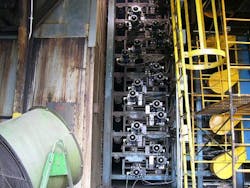When the Rock-Tenn paperboard mill in Aurora, Ill., wanted to automate the positioning and tensioning of belts on its conveyor system, it took more than a year to find a vendor capable of meeting the project budget and specifications. Management wanted a turnkey solution with high accuracy at a cost that precluded traditional approaches using servo or stepper technology, which would have been overkill given the small degree of stroke required. It took a combination of high-end, absolute encoders and basic, low-end control and drive technology to get the job done.
The Aurora mill, in operation since 1909, manufactures 100% recycled content binders board for, among other things, textbook covers. The continuous sheet is formed at a rate of 500 feet per minute, then cut into 21-ft lengths that are fed through a five-deck, natural gas-fired dryer about 30 ft high. Each of the 10, 170-in.-wide wire mesh carrier belts carrying board through the dryer has a tendency to wander towards the side of the conveyor frame, due to heat expansion.
If not re-centered, belts rub against the frame, incurring damage. Employees needed to climb up scaffolding beside the conveyor structure and, using a wrench, re-center the two carrier wires for each deck by cranking on a threaded rod and nut. That would happen at roughly 20 to 30 minute intervals and take 30 to 45 seconds per wire. The air is a humid 240° F exiting the dryer and working anywhere near it is unpleasant in any season, according to John Goll, the mill’s assistant general manager.
Several engineering houses and contractors declined to bid on the project, while others quoted prices well in excess of Goll’s budget for automating the adjustments. As the months slipped by, Goll began contemplating other uses for the funds. That’s when Chicago Electric heard about the project and submitted a design employing FRABA POSITAL optical encoders from FRABA Inc., Hamilton, N.J. The encoders, used in conjunction with a DeviceNet network, were the catalyst to delivering high-end performance on a small budget.
“The belt is not moving far and it’s not moving fast, but we still needed high resolution so it had to be absolute encoders,” says Chicago Electric president Robert Kaska. “It’s not something you could do with a linear potentiometer or other positioning sensor.”
The hardware package Chicago Electric proposed included one FRABA OPTOCODE (OCD) DeviceNet encoder and one half hp Marathon ac motor for each of the 30 axes, Control Technique half hp ac vector drives, an Allen Bradley Control/Logix PLC, and a RedLion G3 touchscreen. The choice of the DeviceNet encoders, DeviceNet network (with a single DeviceNet card), and relatively inexpensive drives, motors, and PLC kept the quote at just under $200,000. A more typical solution with servo or stepper technology and separate encoder cards for each of the 30 encoders would have cost 30 to 50% more, according to Kaska.
Each OCD absolute encoder uses an integrated Opto-ASIC that provides up to 30-bit multi-turn resolution and can withstand the heat near the dryer. The Aurora design is a variation of Chicago Electric’s FAST (Flexo Automated Setup Technology) system, a retrofit package that exploits the high resolution capability of FRABA optical encoders in automating positioning on converting machines in the corrugated box industry. At Aurora, the system was installed first as a prototype on one conveyor deck and later on the other four.
That replaced a completely manual process with a fully automated closed loop for positioning the belts as well as partial automation for tensioning, a smaller issue. If a belt slackens, a worker taps a button on the touchscreen to take up the slack. With the new system in place, maintenance time spent in the dryer area has been reduced by about 50%. For more information, visit fraba Inc.

